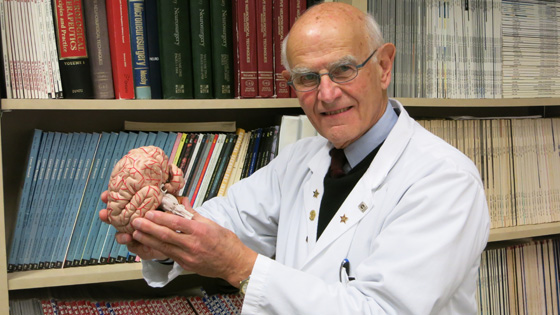
Findings from a new study published by Dr. Charles Tator and the CSCP research team, provide some insight on how concussions affect the young, developing brain and what conditions might lead to a diagnosis of post-concussion syndrome. (Photo: UHN)
A concussion is now established as a brain injury that can have long lasting effects for some individuals, but there is still much to learn about this injury and its symptoms in order to understand how it develops and determine what treatments will help patients.
Researchers with the Krembil Neuroscience Centre's Canadian Sports Concussion Project (CSCP) have added another piece towards solving the concussion puzzle with a study on post-concussion syndrome (PCS) published in the journal, Neurosurgery in September. Individuals who do not recover within the expected timeframe after sustaining a concussion are diagnosed as having post-concussion syndrome.
The study, led by Dr. Charles Tator, neurosurgeon and project lead for the CSCP, reviewed the medical and demographic data among 138 young athletes to explore the common symptoms resulting from PCS and their possible causes. Known as a retrospective study, this type of research examines the medical records of groups of individuals who are alike in many ways and compared for a particular outcome, in this case the development of PCS.
PCS and the adolescent brain
Though more research is needed on concussions and their resulting conditions such as PCS, the findings from the research provide some insight on how concussions affect the young, developing brain and what conditions might lead to a PCS diagnosis. Findings from the study include:
- Half of the athletes who developed PCS were under the age of 18.
- Eighty per cent of patients diagnosed with PCS had at least one other previous concussion.
- PCS was associated with an average of almost eight symptoms per athlete, including headaches, memory disorders, sensitivity to light, anxiety and blurred vision.
- In 20 per cent of the patients, PCS occurred after the first concussion. Another 20 per cent developed PCS after a second concussion.
- Among patients with two or more concussions, more male than female patients suffered from PCS.
- Due to the young age of most patients with PCS, researchers theorize the incidence of PCS among adolescents may be higher than previously recognized, and could indicate that adolescents are at higher risk of developing the condition as well as slower to recover from it.
- PCS lasted three months or longer in two-thirds of the patients. On average, patients suffered from PCS for six months, but cases as short as one month and as long as 14 years were also observed.
- The duration of PCS and the number of symptoms associated with the condition were not related to the number of previous concussions or whether a patient had lost consciousness because of a concussion – indicating that more research is needed to determine the exact contributing factors to development of PCS.
"Upon review of this information, it was amazing to discover that so many young people are continuing to suffer for a long time from PCS," said Tator. "This study not only underlines the seriousness of concussions, but also that, in some people, this injury has a significant and lasting effect on the brain."
Effects that last a lifetime?
Studying athletes with PCS will help researchers collect useful information to determine what long-term consequences may occur as a result of sustaining repetitive concussions.
A long-term study based on the same patients is currently underway to determine the total duration of PCS and whether the condition can predict if a patient will develop chronic traumatic encephalopathy (CTE), a condition that causes brain degeneration and thought to be associated with sustaining multiple concussions.
The Canadian Sports Concussion Project conducts research into all aspects of concussions that occur in sports to shed light on their effects. It is the world's first program dedicated to a four-pronged approach to concussions – research, education, diagnosis and treatment.
This study is the fourth research paper published by the group which includes a team of world leaders in brain injuries, imaging, genetics, clinical care, neuropsychology, psychiatry and neuropathology -- all focused on better understanding and finding treatments for concussions.
Related Links
